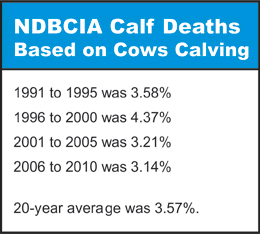
Kris Ringwall
Beef Talk
At what level of death loss does an individual producer become concerned?The death of a calf never is uneventful. Calves are tough, so most survive in good or bad weather. However, some don't survive.
When it's cold, the weather is blamed for the death of a calf. In reality, each year producers arrive at the calving pen and are discouraged after finding an occasional dead calf.
 The North Dakota Beef Cattle Improvement Association (NDBCIA) benchmark for calf death loss is 3.14% based on the number of cows calving. Simply put, 3.14% of the cows do not get the opportunity to nurse the calves they bore. The frustration is real, but sometimes there is very little a producer can do.
The North Dakota Beef Cattle Improvement Association (NDBCIA) benchmark for calf death loss is 3.14% based on the number of cows calving. Simply put, 3.14% of the cows do not get the opportunity to nurse the calves they bore. The frustration is real, but sometimes there is very little a producer can do.
Years spent calving and lambing would suggest that those babies intent on living will survive birth. Vigor is critical, but there are real differences in baby calves. Some calves have not even hit the ground and they already are shaking off the placenta and all other prepackaged birth membranes and fluids.
Newborn calves with their heads up and eyes open are a joy to see, because these calves don't wait for mama to give them a nudge; they just go. In some cases, mom hardly has enough time to clean the little tyke before the calf is up and nursing.
Then there are those who don't seem to ever get with the program. Some expire, having never cleared their nose or broken free of the birth membrane. Mom delayed a bit and the calf simply never breathes. Some lay around long enough for the coyotes, while others simply slip away under the passage of the herd. The individual vigor and the desire to live were not there.
Those first hours are critical, but occasionally calves die for a variety of reasons, such as clostridia, ulcers, starvation or accidents. The list goes on and on. Even in good weather, a mix of several problems during the first couple of weeks of life often implies stress, overcrowding, problems in cow-calf pair management or lot conditions. These problems with calves can carry over into health issues later on during the summer and fall or even in the feedlot.
Excuses abound and blame is cast for not being there. Perhaps, as beef producers, we really do not need to carry all the blame. The calf died. Economically, this is not a good thing because every calf carries a significant price tag and tremendous opportunity to make some money.
However, there is reality. Not unlike counting one's chicks before the eggs hatch, not all will survive. The point is the question: At what level of death loss does an individual producer become concerned? Is there a fundamental problem that can be corrected?
We understand that spring is a season of new life, but death is never far away. Perhaps that is why so many children who grew up in a barnyard developed a little more understanding of life and death.
In the bigger picture, as we try to get a handle on what is normal, some reflection is needed. To start with, we can try to find a deer in the hayfield, an antelope across the pasture or a wildebeest on the Africa plains that is having birthing difficulty. These are very difficult to find, as is the wild newborn that lies listlessly after birth.
The natural birthing process is meant to be unassisted and unattended. Given that, maybe we should ask how far we have come from redoing something Mother Nature has done already. What is normal or what does Mother Nature suggest? Well, our cows and calves are not on the African plains, and we do not like to stand by idly if one of our cows or calves is having trouble, so one should ask just what would be expected and review whatever data are available.
Looking back at data from NDBCIA producers, the average calf death loss from 1991 to 1995 was 3.58%. From 1996 to 2000, the losses averaged 4.37%. From 2001 to 2005, the losses averaged 3.21%, and from 2006 to 2010, 3.14%. This gives us a 20-year average calf death loss of 3.57% based on cows having calves.
Interestingly, the year with the greatest calf death loss was 5.64% in 1997. The spring blizzard of 1997 resulted in a very difficult calving season. The year with the least calf loss was 1991, with 2.68%. The next best year was a 2.9% loss in 1998.
So, develop a list of your dead calves. You should be under 3% death loss. Your calving notebook should have the dead calves checked off and a brief notation about what happened. Until all the calves are listed, the shock of lost opportunities has not had its full effect. Again, try hard for less than 3% calf death loss.
If your operation has more than a 3% loss, start looking for problems so you can fix them.
May you find all your ear tags.
Your comments are always welcome at http://www.BeefTalk.com. For more information, contact the NDBCIA Office, 1041 State Ave., Dickinson, ND 58601, or go to http://www.CHAPS2000.com on the Internet.











